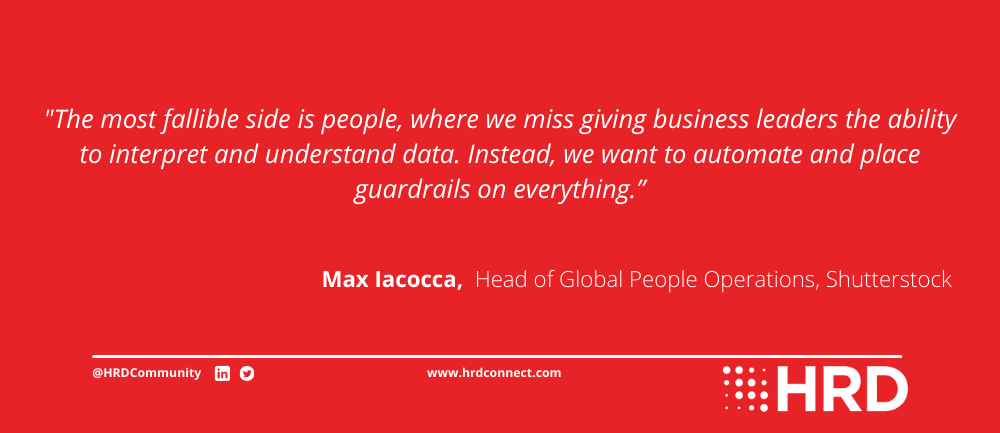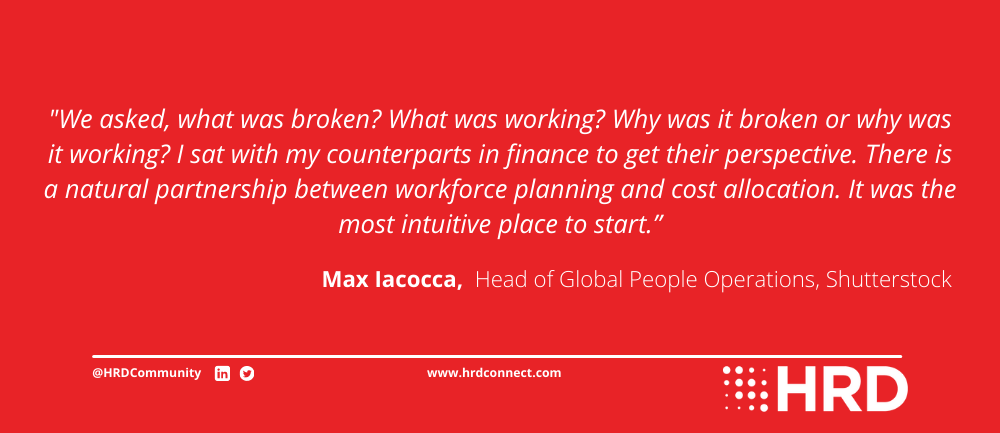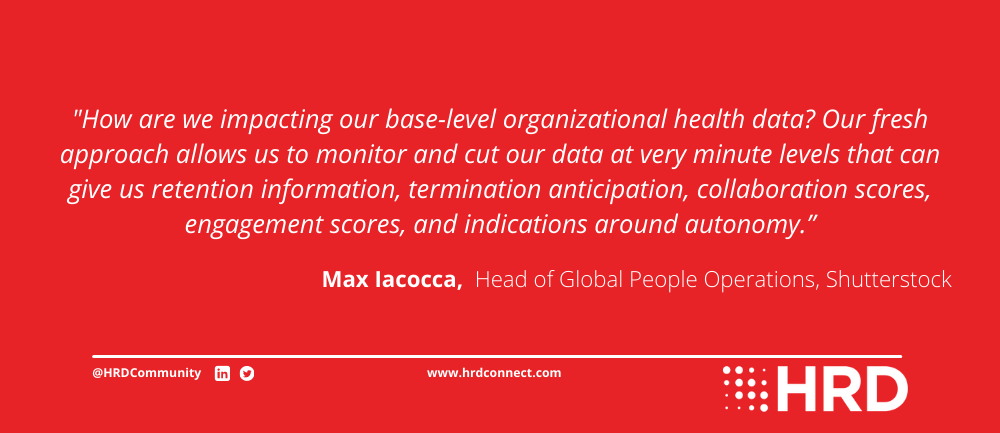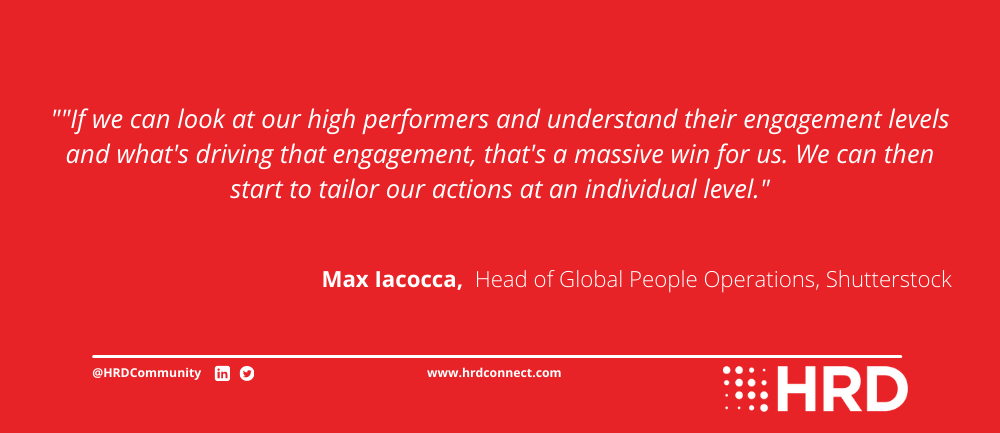-
Provided by

- Date published: Mar 27, 2023
- Categories
In today’s fast-paced and competitive business landscape, companies are constantly seeking innovative ways to improve employee engagement and retention. One organization that has taken the initiative to new heights is Shutterstock. Max Iacocca, Head of Global People Operations at Shutterstock, has been instrumental in implementing data analytics to revolutionize the way the company approaches employee engagement and inclusion.
In this exclusive case study, we delve into the insights and experiences of Max Iacocca as he shares Shutterstock’s journey in scaling its data analytics operations to improve employee engagement, retention, and overall performance, and offers a rare glimpse into how a global organization has successfully turned data into actionable insights, helping to drive a more inclusive, engaging, and high-performing work environment.

The challenge: Bridging the data gap and empowering autonomy
Shutterstock faced two primary obstacles: A lack of detailed data offering actionable insights and a top-down approach to managing engagement which restricted autonomy within lower levels of the organization.
The former was compounded by traditional engagement surveys that provided limited information, leaving Shutterstock struggling to pinpoint areas requiring improvement or attention.
The latter, according to Iacocca, is symptomatic of industry-wide challenges with people analytics schemes. “Even with a small budget, there are cheap and accessible tools. The most fallible side is people, where we miss giving business leaders the ability to interpret and understand data. Instead, we want to automate and place guardrails on everything.”
Determined to overcome these challenges, Iacocca’s immediate priority was creating consistency around definitions and reporting periods to align stakeholders on people data and minimize data inconsistencies. Shutterstock could then focus on implementing the necessary infrastructure to support and empower managers to leverage data insights.

The power of managers
Making data analytics digestible and desirable is challenging but rewarding for HR and People teams. Shutterstock has shifted its culture to upskill its managers and create processes, programs, and guidelines to enable managers to be more autonomous. This has reflected a broader industry shift of HR away from traditionally administrative to strategic business partners. Iacocca advocates for “having a tight partnership between your HR business partners and their understanding of data, the business strategy, and what they are trying to achieve.
“We asked, what was broken? What was working? Why was it broken or why was it working? I sat with my counterparts in finance to get their perspective. There is a natural partnership between workforce planning and cost allocation. It was the most intuitive place to start.”
Immediately there was a clear disconnect between divisions, and a need to synchronize data strategy between the two functions.
To resolve this all-too-common problem, Iacocca collaborated closely with his peers in finance to normalize and standardize definitions and reporting periods. Having defined an initial language library, Shutterstock’s HR team could then define whether data inconsistencies were down to bad definitions, broken processes, human error, or machine error.
This helped Shutterstock quickly address some issues around reporting and ensure managers were equipped with accurate data. Step one on the path to democratizing data was completed. However, it also revealed several core unhealthy processes Shutterstock needed to address as part of a much larger program to rebuild its people data analytics strategy.

Data analytics spotlight: Employee engagement survey
“We can’t go from zero to one hundred,” Iacocca acknowledges. “We must pick and choose our battles.” One of the skirmishes Shutterstock selected to prioritize was its employee engagement survey.
Ubiquitous across nearly every organization, employee engagement surveys exist in a variety of formats but many organizations still make major mistakes. Historically, a traditional provider ran Shutterstock’s employee engagement survey. The provider presented results to senior business leaders who planned actions around the survey. This top-down approach prevented managers from tapping into invaluable employee insights and adjusting their processes and team relationships accordingly.
With the help of a new partner, Shutterstock sought to implement a more accessible, flexible, and agile solution for engagement surveys and qualitative data collection. The hope was that this novel approach to surveying would help foster a more inclusive and engaged workforce. “A core focus was to integrate engagement survey data with our workforce data,” says Iacocca.
Shutterstock’s HR division, like many organizations, was seeking to understand how it was impacting employee engagement, including among diverse employees. Iacocca explains further:
“How are we impacting our base-level organizational health data? Our fresh approach allows us to monitor and cut our data at very minute levels that can give us retention information, termination anticipation, collaboration scores, engagement scores, and indications around autonomy.”
Connecting managers with survey analytics
But even with a new platform in place, without a rigorous transformation in process, Shutterstock’s managers remained restricted in their autonomy to act on insights. Accordingly, it granted managers with teams of five or more participants access to in-depth breakdowns of their team’s data. This represented a significant departure from the top-down approach, empowering managers to assume responsibility for their team’s engagement and performance. “We’re able to drive that accountability and autonomy for this data into all levels of the organization. It stops us continuing our top-down push,” Iacocca noted.
The modified approach to employee engagement surveys also allowed Shutterstock to compare its data analytics around performance against industry benchmarks. In turn, this helped identify areas of strength and weakness.
“We can start to tailor our actions at a people team level, but more importantly, at a managerial level, our people leaders can support and empower individuals who are on the fence about Shutterstock into highly engaged employees with a high NPS (Net Promoter Score).”

High performers, underrepresented groups, and geographic locations
Armed with data, Shutterstock gained an improved understanding of high performers, underrepresented groups, and geographic locations. This informed the development of future initiatives, enabling the company to create targeted strategies for employee engagement and development.
Iacocca emphasized the importance of equipping managers with this granular level of employee data and insights broken down based on demographics. “I think it’s always interesting when you can look at data at that level because it allows us to have much more targeted, focused discussions on specific groups of individuals.
“If we can look at our high performers and understand their engagement levels and what’s driving that engagement, that’s a massive win for us. We can then start to tailor our actions at an individual level.”
By tailoring initiatives to enhance these employees’ engagement and impact, Shutterstock could capitalize on their previously untapped potential.
Where next on Shutterstock’s path to data analytics democratization?
Shutterstock’s investment in data and technology laid the foundation for continuous improvement by enabling ongoing measurement of the company’s efforts. It has demonstrated the importance of experimentation to HR and the wider business function. Iacocca expressed his excitement about the future, saying, “The investment in our platforms and our data will give us the ability over the next six to twelve months to measure our initiatives on an ongoing basis, which we’re excited about.”
As Shutterstock looks to the future, the company plans to focus on several key areas, including further developing D&I data, exploring mobility data, and identifying high-risk employees to maximize retention. Iacocca highlighted the potential benefits of mobility data, explaining, “I think understanding the mobility of our people will give us some really interesting insights into what’s working, what’s not, and where we may need to sort of rethink some of our strategies.”
Shutterstock will continue experimenting with new ways of driving engagement and inclusivity, using data to measure the impact and adapt as needed. Shutterstock has set the stage for ongoing growth and improvement by investing in data analytics and technology and transforming the way the company approaches employee engagement and the overall employee experience.


